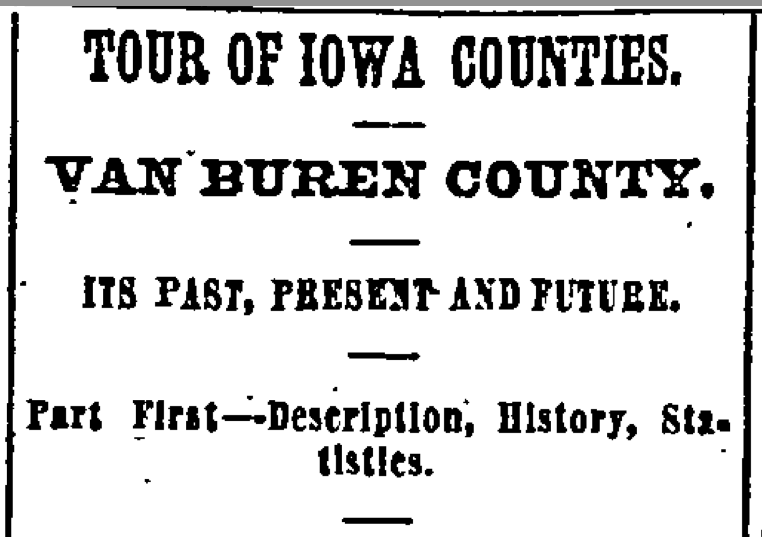June 10 1868 - Daily Iowa State Register - Des Moines, Iowa - Vol
VII - Issue 139
| No. of dwelling
houses |
2,780 |
| No of white males |
8,165 |
| No of white females |
9,944 |
| No of colored males |
86 |
| No of colored females |
77 |
| No entitled to vote |
3,491 |
| No of militia |
2,359 |
| No of foreigners not naturalized |
43 |
| No between the ages of 5 and 21 |
6,032 |
| No of blind |
9 |
| No of deaf and dumb |
8 |
| No of insane |
6 |
| No of students attending college |
118 |
| No miles of railroad |
30 |
| No colleges |
1 |
| Value of manufacturers for 1866 |
$263,236 |
| Bushels of coal raised |
71,170 |
| Value of minerals raised, not including
coal |
$27,312 |
| Value of agricultural implements |
$196,280 |
| No rods of hedging |
32,840 |
| No of acres of land inclosed |
123,634 |
| No of acres of spring wheat for 1866 |
6,224 |
| Bushels harvested |
50,062 |
| No acres of winter wheat |
7,734 |
| No of bushels harvested |
69,052 |
| No acres Oats |
8,469 |
| No bushels harvested |
248,627 |
| No acres of corn |
35,864 |
| No bushels harvested |
999,460 |
| No acres of Rye |
1,860 |
| No bushels harvested |
22,599 |
| No acres of barley |
44 |
| No bushels harvested |
759 |
| No acres of Sorghum |
506 |
| No gallons syrup from Sorghum |
46,915 |
| No acres of Hungarian grass |
380 |
| No tons of hay from Hungarian
grass |
459 |
| No acres of tame grass |
24,409 |
| No tons of hay from tame grass |
18,397 |
| No tons of hay from wild grass |
363 |
| No bushels of grass seed |
11,149 |
| No acres of Irish potatoes |
657 |
| No bushels harvested |
31,235 |
| No bushels of sweet potatoes |
2,128 |
| No bushels of onions |
3,792 |
| No acres of flax |
347 |
| No bushels flax seed |
1,798 |
| No pounds of lint |
1,250 |
| No acres of all other crops |
508 |
| No of fruit trees in bearing |
57,856 |
| No of fruit trees not in
bearing |
92,195 |
| No of pounds of grapes raised |
16,814 |
| No of gallons of wine made |
512 |
| No of pounds of hops raised |
774 |
| No of pounds of tobacco raised |
9,295 |
| No of acres planted for timber |
6 |
| No hives of bees |
2,882 |
| No of pounds of honey taken |
23,000 |
| No of pounds of beeswax |
983 |
| No of hogs of all ages |
36,136 |
| No of cattle of all ages |
15,698 |
| No of milch cows |
5,733 |
| No of pounds of butter made |
331,660 |
| No of pounds of cheese made |
19,262 |
| No of work oxen |
207 |
| No of sheep in 1866 |
41,352 |
| No of pounds of wool shorn in 1866 |
134,265 |
| No of sheep in 1867 |
48,065 |
| No of horses of all ages |
7,517 |
| No of mules and asses of all
ages |
769 |
| No of dogs |
2,165 |
| No of sheep killed by dogs |
1,420 |
| Value of sheep killed by wolves |
$474 |
| No of acres of land assessed |
305,350 |
| No of acres of land enclosed |
123,684 |
| Assessed value of land per
acre |
$8.07 |
| Assessed value of land and town lots |
$2,814,693 |
| Assessed value of personal
property |
$1,341,458 |
| Total valuation |
$4,156,151 |

